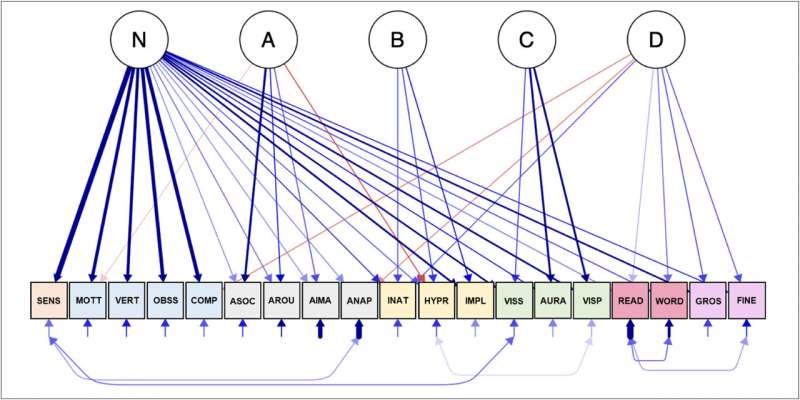This article has been reviewed according to Science X's editorial process and policies. Editors have highlighted the following attributes while ensuring the content's credibility:
fact-checked
trusted source
proofread
Understanding neurodiversity across the UK population: Study

A new study has provided insight into how experiences and features of neurodiversity vary among adults in the UK.
There is variation in people's attributes and experiences across all populations. Neurodivergent people, such as people with a diagnosis of ADHD, dyslexia, dyspraxia, or autism, may experience the world in distinctive ways. But, we are only beginning to appreciate how traits and experiences associated with neurodivergence differ across the whole population.
New research from the University of Birmingham has provided a more detailed picture of what neurodiversity looks like among adults in the UK.
The research is published in JCPP Advances.
Ian Apperly, Professor of Cognition and Development and Director of the Centre for Developmental Science at the University of Birmingham, who led the study, said, "People's experiences of neurodevelopmental conditions are highly variable, and it is common for people to have more than one condition. Previous research has found, for example, that the prevalence of ADHD among autistic people is around 40%."
"We also know that people show traits associated with neurodiversity to varying extents across the entire population; it's not just people with a diagnosed neurodevelopmental condition whose experience is influenced by these traits. What we don't have is a detailed understanding of what this looks like. This raises important questions that can inform our understanding of the complexity of neurodiversity across the general population."
Professor Apperly and his team asked 1,000 people representative of the UK population aged 18-70 to report on their experiences of characteristics commonly associated with autism, ADHD, dyslexia, and other conditions. For example:
- High scores for characteristics associated with autism were linked with experiences of challenges with social and imaginative skills, higher preference for routines, and attention to details, numbers, and patterns.
- High scores for characteristics associated with ADHD were linked with tendencies for inattentiveness, hyperactivity, and impulsiveness.
- High scores in cortical hyperexcitability were connected with visual sensitivity and unusual visual experiences.
- High scores for characteristics associated with dyslexia were linked with lower fluency in reading and word-finding.
Although characteristics associated with different neurodevelopmental conditions are often considered separately, the research found that when examined at the same time there were high levels of overlap, so people reporting high characteristics for one condition, also tended to report experiences associated with other conditions.
However, the research also found evidence of distinctive characteristics associated with specific conditions, above and beyond this general shared neurodiversity.
Professor Apperly explained, "We found that there is considerable overlap in the broader characteristics associated with different neurodevelopmental conditions so that people with higher levels of characteristics associated with one condition (e.g., ADHD) are also more likely to have higher levels of characteristics associated with other neurodevelopmental conditions (e.g., autism, dyslexia, dyspraxia, tic disorders)."
"But we also discovered that the same traits can be explained by different underlying causes. For example, some people reported high levels of several traits associated with autism, even though they did not report high levels of neurodivergent characteristics overall, while other people reported high levels of autistic traits alongside high levels of traits associated with other conditions. And some combinations were particularly unusual."
"For example, people showing high levels of traits associated with dyslexia and dyspraxia tended not to show high interest in numbers and patterns."
This study is the largest examination to date to explore the diversity in how characteristics relating to neurodevelopmental conditions are expressed among adults in the UK. The researchers say that it has provided critical benchmark data and a framework approach for examining neurodiversity in the whole population, including people with one or more diagnoses.
Professor Apperly concluded, "Our findings help make sense of the complexity of neurodiversity. They help us understand characteristics and experiences that might be common across neurodevelopmental conditions, as well as those that are distinctive. The study also helps us understand how two people with the same diagnosis might nonetheless have rather different characteristics and experiences."
"By providing a picture of how neurodiversity appears across the whole population, this research can go on to inform improvements for future studies in this area. The more we know about other people's experiences, the better we can understand each other."
More information: Ian A. Apperly et al, A transdiagnostic approach to neurodiversity in a representative population sample: The N+ 4 model, JCPP Advances (2024). DOI: 10.1002/jcv2.12219





















